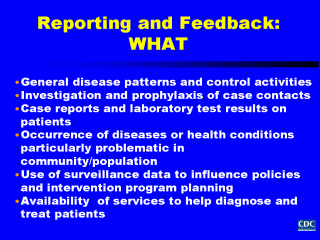| front |1 |2 |3 |4 |5 |6 |7 |8 |9 |10 |11 |12 |13 |14 |15 |16 |17 |18 |19 |20 |21 |22 |23 |24 |25 |26 |27 |28 |review |
 |
Providing regular feedback reinforces the importance of participating in pubic health surveillance. Feedback should be timely, informative, interesting, and relevant to the needs of the individual or group to which it is provided. For example, for health care providers, information about disease patterns and control activities in their area that can affect how they practice is important, while for schools and occupational settings, surveillance information on investigation and prophylaxis of contacts of cases are important to determine how best to limit the spread of disease in their institutions. In general, no matter which group you are providing feedback to, use every interaction to discuss cases and surveillance issues in general. What kinds of information is useful to provide? For clinic- and community-based health care providers, and infection control and laboratory personnel general surveillance summaries which include total case counts and characteristics of case patients are helpful as is information on the disposition of individual cases they reported to your surveillance system. In addition, laboratory reports can be matched with physician reports and for cases reported only by the laboratory, physicians notified about these missing cases which should have been reported from their practices. Another type of information that is useful is one which heightens the awareness of providers concerning the importance of looking for and reporting cases of diseases or health conditions of particular interest. For example, for infectious and vaccine-preventable diseases, special efforts could focused on health care providers who see immigrants and travelers returning from international settings to look for and diagnosis suspected cases of these diseases. In a similar fashion, physicians and nurses working in occupational settings can be encouraged to look for and report cases of exposure to toxins, and occurrences of injuries to the appropriate surveillance system. Examples of how data reported to the surveillance system was used to influence or change policies and programs can be provided to health care providers as well as schools, occupational settings, the press, and the public. Information about new medications, state-of-the-art laboratory diagnostic services, and other services available to help diagnose and treat patients and their contacts to limit the spread of disease is also useful for all the different types of audiences you feedback information to. |
| front |1 |2 |3 |4 |5 |6 |7 |8 |9 |10 |11 |12 |13 |14 |15 |16 |17 |18 |19 |20 |21 |22 |23 |24 |25 |26 |27 |28 |review |